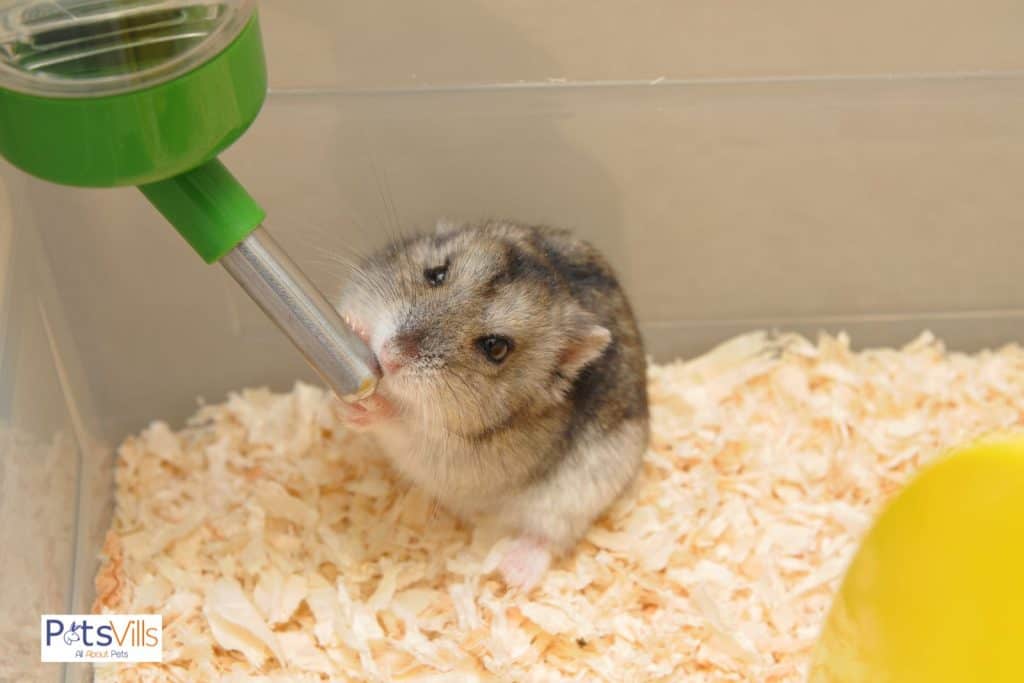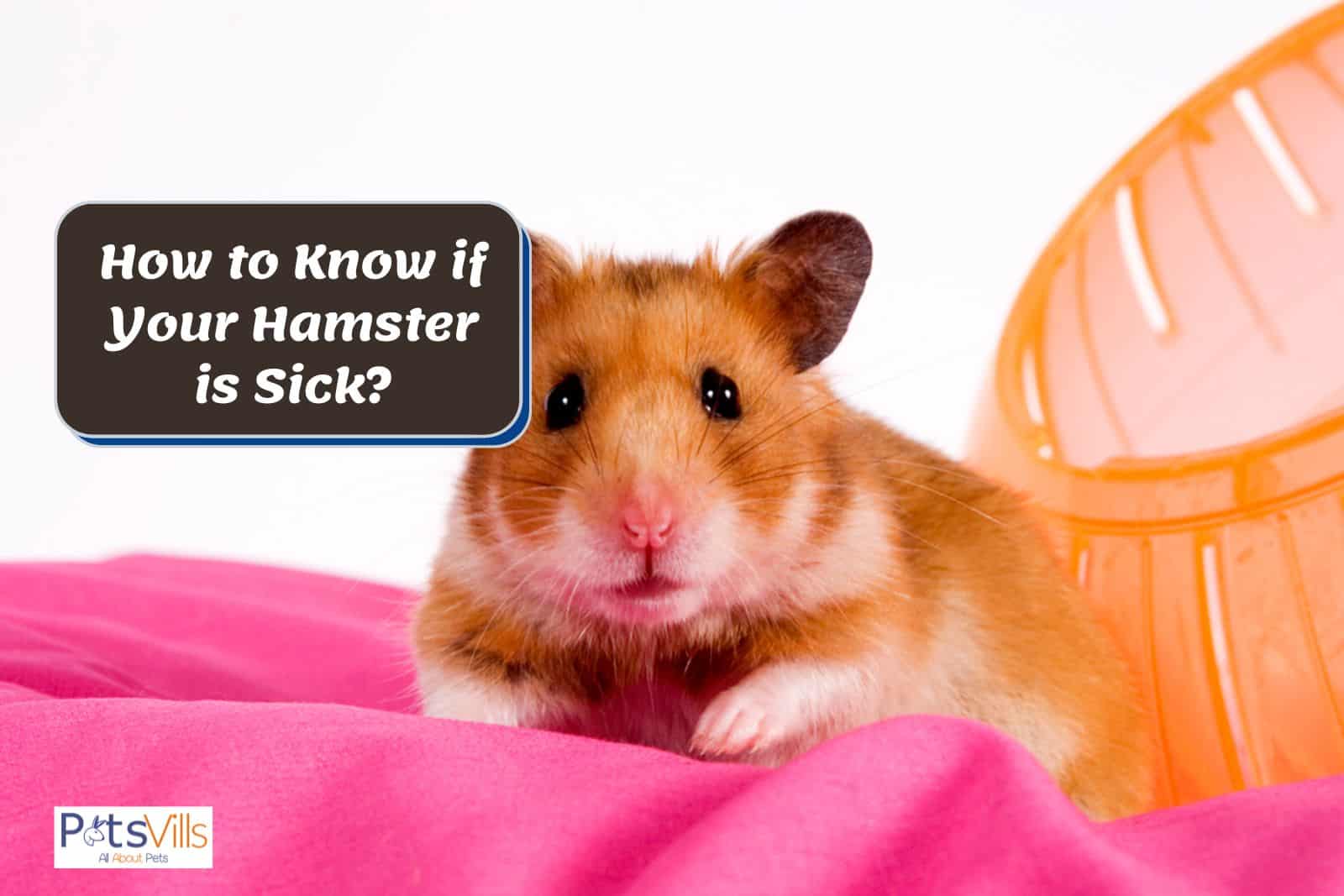Are you wondering how to know if your hamster is sick? Every hamster owner can empathize with this feeling as it’s frightening to contemplate if your hammy is ill.
According to experts, it’s a shared experience as hamsters are prone to several illnesses, from respiration infections to various tumors (1).
So owners need to know the classic sick hamster symptoms, conditions, and treatments.
Read on, and you’ll soon learn everything about them.
Table of Contents
Quick Summary
- Sick hamsters often hide their illness better than other pets. But there are a few noticeable symptoms, such as weight loss, fatigue, loss of appetite, and sneezing.
- Identifying sick hamsters requires monitoring changes in their appearance, behavior, and stool.
- Hamsters are prone to picking various illnesses and conditions. Some common ones include wet tails, diarrhea, tumors, and respiratory infections.
- Treating sick hamsters is about keeping them hydrated, adjusting their diet, minimizing activity, and ensuring they stay warm. Schedule a vet visit if they don’t improve after a few days.
Common Symptoms of a Sick Hamster
Hamsters are rather coy about them having a sickness. These little furballs will make it challenging to see if something is causing them discomfort or showing signs of pain.
But there are some signs of illness a vigilant owner will see. Here’s a quick list of common signs and symptoms to look out for when checking your hammy:
- Weight loss
- Fatigue
- Lack of movement
- Hair loss
- Sneezing
- Lump formations beneath their skin
- Shivering
- Loss of appetite
- Shortness of breath or wheezing
- New-found fearfulness
- Runny nose
- Diarrhea
- Wet tail area
- Unkempt coat or matted fur
- Increased itchiness
- Rapid breathing and increased heart rate
- Eye, nose, or ear discharge
Of course, this list is only a short overview of possible symptoms. Our next section will further demonstrate this variation by showing all the common conditions and illnesses.
But this list does provide a good starting point. It should help determine whether something is wrong with your hammy.
How to Identify a Sick Hamster?
Since you know what to look for, let’s review how to check for them. It’s vital to use this step-by-step process so you can be sure about how to care for hamsters.
1. Look for Differences in Your Hamster’s Appearance
The most telling sign of a sick hamster is a disheveled appearance. So look into their cage and see whether there are any visible symptoms.
Examples include nose discharge, matted fur, lumps, or swelling. Honestly, any abnormal sign is a cause for worry.
I’d also recommend doing a thorough check by holding your hammy. It’ll offer a more direct ability to observe any symptoms or troubling signs.
2. Monitor Their Behavior
Your hamster’s behavior is another indicator of how they’re feeling. In short, a sick hamster won’t be too fond of doing all regular activities.
Sick hamsters often will have significant drops in energy or be overly aggressive. These are classic signs that your hammy is a little down in the dumps.

Another telltale sign is a newly found sensitivity to light. If this symptom pops up, veterinary attention is needed to see what’s causing the issue.
The easiest way to monitor is by doing daily checks and observing them. If you do, it becomes easier to tell when there’s a change in their normal behavior pattern.
3. Check Your Hamster’s Stool
This step isn’t ideal as it’s rather gross. But it’s vital to check whether your hamster is experiencing diarrhea or constipation.
These symptoms indicate something is wrong with your hammy’s digestive tract. So it’s critical to observe and see whether anything has changed.
4. Determine Whether They’re Sick
Schedule a vet visit immediately if anything abnormal pops up during your checks. You’ll want to attack these symptoms head-on rather than wait for them to disappear.
Related: Know the Signs of Hamster Dying
Notable Hamster Conditions and Illnesses
One thing is sure about hamsters; they aren’t the cleanliness or healthiest pet. These lovable furballs are prone to a variety of conditions and illnesses.
But most sick hamsters have one of these seven common illnesses and conditions to blame:
1. Wet Tail
The wet tail has wreaked havoc on many long-haired hamsters. It’s a bacterial infection that can cause dehydration, severe constipation/diarrhea in hamsters, or “discharges from the urinary tract” (2).
Sadly, if this condition isn’t treated quickly, it can become fatal. So it’s vital to know the following signs of illness so that you can treat it immediately:
- Matted/wet tail fur
- Abnormal aggression
- Hunched posture
- Severe diarrhea
- Constipation
2. Paralysis
Paralysis is more common than people realize in hamsters. It can occur from them not getting enough exercise, dealing with a spinal injury, or lacking vitamins in their diets.
So if your hamster’s dragging a hind leg or minimized its movement, it could be paralysis. It’s best to speak with a vet immediately if it’s even a possibility.
3. Diarrhea
Diarrhea can make your hamster’s life an absolute nightmare. It’ll create a situation where they want to do little around their enclosure.
In most cases, diarrhea comes from introducing a new item into their balanced diet. The obvious treatment would be removing it if you did use new hamster food.
Most diarrhea cases will disappear within a day. But if it lasts longer, this condition can dehydrate your hammy and kill them.
Given this info, you must see a vet when diarrhea continues for more than a day.
4. Tumors
Tumors are a scary word for any pet owner to read. But hamsters are known for picking them up on parts of their bodies, presenting themselves as lumps or bumps.
So anyone who notices them when holding or checking their hamster needs to call a vet. It’s probably the reason your hamster has seemed sick or behaving differently.
5. Lice and Fleas
Lice and fleas are an annoying nuisance for any animal with abundant fur. Hamsters aren’t any different and will result in constant rubbing and itching when infected by them.
Please make sure to address them immediately before they start spreading elsewhere. I had a friend whose hamster had fleas, which led to all his animals having them.
Trust me; this situation isn’t what any pet owner wants to experience.
6. Respiratory Infection
Hamsters aren’t immune to catching a cold or the flu. Respiratory infections are the most common cause of a hamster seeming sick (3).
Your hamster can pick up a respiratory infection from both bacteria and viruses. Plus, it can be transmitted to other animals or even humans.
So hamster parents must be cautious when handling a pet hamster with respiratory infections. Avoid it altogether if possible.
Related: Why Do Hamsters Die So Young?
6 Tips to Help a Sick Hamster
Pet parents can take specific measures to help their hamsters get through their illness. Each one of these tips that’ll give your hammy the best odds possible.
1. Adjust Their Diet
Dealing with the lack of appetite can be quite a battle for hamster owners. But, unfortunately, it can turn perilous as hamsters can survive long without food.
So if your hamster stops eating, adjust its diet to include higher-calorie foods. A small number of hard-boiled eggs would be a fine example.

This high-calorie food will be much easier for them to eat. But don’t let them consume all the food without taking a break, or the problem may worsen.
Meanwhile, another food-related trick is moving their bowl closer to their sleeping area. This small action could give them enough incentive to eat.
2. Make Your Hamster Warm
Hamsters are similar to humans when it comes to feeling cold during sickness. So you’ll need to account for this issue by trying to keep them warm.
But there’s a delicate balance to this process. If you raise their body temperature too much, it can cause heat stroke.
So it’s more about moving them to a warm place in your home. You’ll also want to provide additional bedding to help fight against the cold.
3. Keep Them Hydrated With Fresh Water
Your sick hamster needs to stay hydrated throughout their illness. So make accessing water easier for them by moving the bottle closer to their sleeping quarters.

Some hamsters may still avoid drinking the water even when it’s placed closer. But you can still use an eyedropper to provide them with water.
I had to go with an eyedropper during my hamster’s last sickness. It turned out to be a godsend as I kept him hydrated until I could finally get him to the vet.
4. Minimize Their Activity
Minimizing your sick hamster’s ability to exercise is a critical step. So I’d start by taking out their exercise wheel and other similar toys.
These components will need to remain outside their cage until they get a clean bill of health. If they don’t, your sick hamster may continue to exercise.
Why would this exercise be a bad thing? Well, it could dehydrate them and make the condition much worse.
5. Write Down a List of Their Symptoms
Owners need to list their hamster’s symptoms as they occur. It’s crucial to provide your vet with all information possible, so this action will make it easier.
It doesn’t have to be fancy; write them down on your phone. You can then pull it and read the symptoms without having to remember.
6. Get Them to a Vet
If your hamster doesn’t improve or worsens after a few days, take them to a vet. I recommend taking them sooner if you’re overly worried about them.
Once at the vet, they’ll diagnose the cause of your hamster’s sickness. Hopefully, it won’t be too severe and will be fixed with quick, effective treatment.
READ MORE: How to Comfort a Dying Hamster
FAQs
What does an ill hamster look like?
Anill hamster will often be lethargic, hunched over, and contain matted fur. Other common indicators include watery eyes, nose discharge, and patchy hair loss.
Can a dirty cage make a hamster sick?

Extended exposure to a dirty cage can make hamsters sick. Therefore, owners must maintain routine cleaning to keep the cage clean if they want a healthy hamster.
Conclusion
How to know if your hamster is sick? It’s all about understanding the common symptoms, doing routine checks, and addressing health issues immediately.
Once an owner knows the signs, it’s easy to identify a sick hamster. They’ll then be well on their way to getting their hamster healthy.

So, do your hamster have any of the above symptoms? Don’t forget to update us on his health!
Resources
- 1. Disorders and Diseases of Hamsters – All Other Pets [Internet]. Merck Veterinary Manual. Available from: https://www.merckvetmanual.com/all-other-pets/hamsters/disorders-and-diseases-of-hamsters
- 2. O’Neill DG, Kim K, Brodbelt DC, Church DB, Pegram C, Baldrey V. Demography, disorders and mortality of pet hamsters under primary veterinary care in the United Kingdom in 2016. Journal of Small Animal Practice. 2022;
- 3. Inflammation of the Lungs in Hamsters [Internet]. www.petmd.com. [cited 2022 Nov 27]. Available from: https://www.petmd.com/exotic/conditions/respiratory/c_ex_hm_pneumonia

My name is Ben Roberts, and I absolutely love animals. So, naturally, I love writing about them too! As far as my animals, I have a Pit-bull, a Beagle-lab mix, a Chihuahua, and one old cat. Each one of them provides me with a new adventure every day. And the best part is they’re all best friends. Well, except the cat when he gets a little annoyed.
FIND HIM ON: FACEBOOK and TWITTER.
Read his latest ARTICLES
Learn more about Benhere


